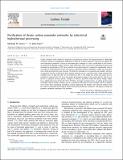Purification of dense carbon nanotube networks by subcritical hydrothermal processing
Author(s)
Durso, Michael N.; Hart, A. John
DownloadPublished version (3.077Mb)
Publisher with Creative Commons License
Publisher with Creative Commons License
Creative Commons Attribution
Terms of use
Metadata
Show full item recordAbstract
Carbon nanotube (CNT)-reinforced composites are promising materials for high-performance, lightweight structures; however, homogeneous infiltration of CNTs by a matrix material is necessary to achieve desired mechanical properties. Critical to overcoming this challenge at scale is purification of CNT materials produced by floating-catalyst chemical vapor deposition. Here, we present a hydrothermal processing technique for purification of CNT yarns, wherein as-received material is exposed to superheated, subcritical water in a hydrothermal reactor. This process selectively removes amorphous carbon and acid impurities while preserving the yarn structure. We find this technique to be consistent and tunable, with processing time directly correlating to linear density reduction up to a saturation limit. Using commerciallyavailable yarns, we find that after 4 h of treatment at 200 °C, the weight loss of the yarn under inert atmosphere is reduced from 12% to 5%, the atomic percentage of oxygen at the surface by 42%, and the ID/IG by 30%. In addition, the yarn specific strength (1.3 N/tex) is preserved, while the specific Young’s modulus is significantly increased by 20% (79 to 95 N/tex). At longer treatment times, we obtain greater purity and higher specific Young’s modulus, but at a substantial reduction in tensile strength, which we hypothesize results from eliminating amorphous carbon toughening CNT bundles. The reported method could be scaled to continuous processing in tandem with post-purification treatments, and appears broadly applicable to different continuous CNT networks.
Date issued
2022-10Department
Massachusetts Institute of Technology. Department of Materials Science and Engineering; Massachusetts Institute of Technology. Department of Mechanical EngineeringJournal
Carbon Trends
Publisher
Elsevier BV
Citation
Durso, Michael N. and Hart, A. John. 2022. "Purification of dense carbon nanotube networks by subcritical hydrothermal processing." Carbon Trends, 9.
Version: Final published version